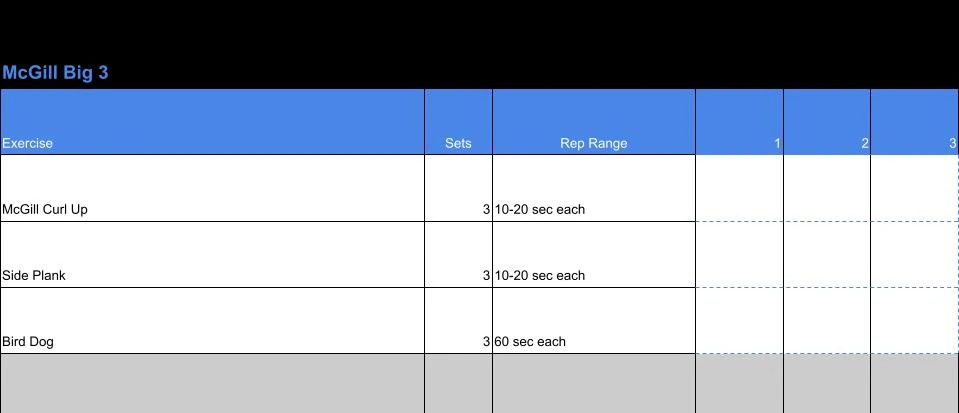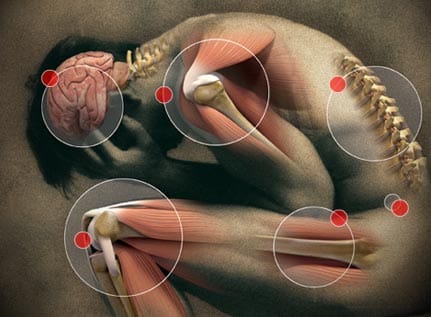The McGill Big 3
3 simple exercises can help improve your lower back pain
Lower back pain is one of the most common ailments people face. In fact, around 90 percent of Americans have chronic, non specific lower back pain.
Dr. Stuart McGill, a renowned expert in lower back biomechanics and pain management, developed a series of 3 exercises designed to strengthen and stabilize the core in order to mitigate lower back pain. These exercises are referred to as the “McGill Big 3”.
These exercises are designed to develop the deep stabilizing muscles of the core, which are important for stabilizing and protecting the spine, unlike some abdominal exercises that include way too much spinal flexion like crunches.
How effective are these exercises? Well, in a six week study, the McGill Big 3 provided greater improvements in reduced pain, improved range of motion and overall stability compared to conventional physiotherapy techniques.
So what are the McGill Big 3 exercises and how can you begin to implement them into your weekly training?
The McGill Big 3
The McGill Big 3 is a series of 3 exercises that aim to improve not just overall back range of motion, but also seek to improve core stability. The goal is to improve the mechanics of the trunk as a whole, rather than the lumbar spine specifically.
The McGill Big 3 consists of:
- McGill Curl Up
- The McGill Curl Up looks like a crunch but it targets the muscles of the upper abdominals while minimizing stress on the spine by having the person place their hands underneath their lower back for support.
- Side Plank
- The side plank targets the oblique muscles or the side abs. Strong obliques help reduce forces on the spine and give it stability.
- Bird Dog
- The bird dog is a dynamic exercise that improves core stability and strengthens your anterior and posterior core musculature, lower back and glutes.
McGill Curl Up
The McGill Curl Up is a safer variation to traditional crunches. By placing your hands under your back, you minimize lumbar extension. The primary objective of this movement is to target the rectus abdominis without putting strain on the lower back.
How to perform the McGill curl up:
- Lie on your back with one knee bent and foot flat on the floor while the other leg is straight out in front of you. Place your hands underneath your lower back. This is to help maintain the natural curve of your spine.
- Brace your midsection and lift your head and shoulders off the floor. Squeeze your abs and “curl’ your upper back forward and away from the floor. Hold this position for 2-3 seconds.
- Slowly return to the start position, keeping tension on your abdominals. Switch leg positions and perform your second repetition.
- Perform 8-10 repetitions. Continue to switch leg positions between repetitions. Avoid any quick jerking movements. Make sure you control your repetitions.
Side Plank
Side planks are a wonderful exercise that I like to use if I ever tweak my back. The obliques, or side abs, are the primary target muscle when performing this exercise. The obliques play a big role in stabilizing the spine. Any time I have dealt with back pain, these have helped me and they are especially good to perform because you are only working one side at a time which allows you to hone in on which side is the problem and allows you to make sure both sides are equal or close to equal in strength.
How to perform the side plank:
- Lie on your side with your body straight and your forearm on the floor. Your elbow should be right under your shoulder.
- Press your hips up so that your elbow so that your elbow and feet are the only points of contact with the floor. You may choose to stack your feet on top of each other or stagger them and have both feet in contact with the floor. You should feel your oblique muscle closest to the floor when performing this movement.
- Hold for 10-20 seconds. Switch sides and perform the side plank again.
- Do 3 sets on each side.
If you need a modification, the side plank can be performed with your knees bent and on the floor to take pressure off your shoulders.
Bird Dog
The Bird Dog is the perfect name for this exercise. I can’t picture what a “Bird Dog” should look like. And when you perform this exercise, you will think, “I bet I look like a bird dog right now”.
The Bird Dog is an excellent exercise for improving lower back and shoulder stability and coordination. It targets both the lower back extensors and the glutes and may test your balance and coordination.
How to perform the Bird Dog:
- Start on the floor with your hands and knees in contact. Your hands should be right underneath your shoulders and your knees should be underneath your hips. This is called the “quadruped” position.
- Extend one arm out in front of you towards the front wall while extending the opposite leg behind you towards the back wall. Your hips and shoulders should remain square to the floor. Pause in this position before returning to the quadruped position.
- Repeat with the opposite arm and leg. Hold this position for 2-3 seconds and switch again.
- Continue for 60 seconds. Make sure you are not over extending your lower back. If this is the case, bring your leg down closer to the floor to reduce the anterior tilt of your pelvis at the top of the movement.
Conclusion
Unlike traditional ab exercises that can increase the strain on your lower back, the McGill Big 3 focuses on spinal stability and trunk stabilization. This allows you to develop the strength of the midsection while minimizing lower back shear.
Consistent training of the McGill Big 3 can help promote long term lower back health. These exercises offer a simple and effective method for dealing with lower back pain. These exercises can be performed anywhere and should be practiced 2 times per week.
Training Plan

You can perform this routine in circuit fashion or one exercise at a time.
Key Takeaways
- Fritz JM, Erhard RE, Hagen BF. Segmental instability of the lumbar spine. Phys Ther. 1998 Aug;78(8):889-96.
- Ghorbanpour A, Azghani MR, Taghipour M, Salahzadeh Z, Ghaderi F, Oskouei AE. Effects of McGill stabilization exercises and conventional physiotherapy on pain, functional disability and active back range of motion in patients with chronic non-specific low back pain. J Phys Ther Sci. 2018 Apr;30(4):481-485.
- Hicks GE, Fritz JM, Delitto A, McGill SM. Preliminary development of a clinical prediction rule for determining which patients with low back pain will respond to a stabilization exercise program. Arch Phys Med Rehabil. 2005 Sep;86(9):1753-62.
- McGill SM. Low back stability: from formal description to issues for performance and rehabilitation. Exerc Sport Sci Rev. 2001;29(1):26-31.






